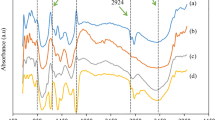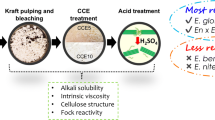Abstract
The objective of the present study was to synthesize sodium carboxymethylcellulose from Eucalyptus nitens cellulose. The cellulose extraction was carried out in three stages. In the first stage, E. nitens wood was fractionated using an organosolv pretreatment (methanol–water 50% v/v, 45 min at 200 °C) followed by an alkaline extraction (NaOH, 1.5 M). Finally, the organosolv pulp was bleached using NaClO2 (1.3% w/v, pH 3.8). The bleached cellulose obtained was converted to sodium carboxymethylcellulose (NaCMC) by an etherification reaction in isopropanol medium. NaCMC structure, morphology and properties were researched using FTIR, 1H and 13C NMR spectroscopy, scanning electron microscopy, and thermogravimetric analysis. The results indicate substitution mostly occurred mostly at the C-6 position of 1 → 4 β-d-glucopyranosyl residues of cellulose chains.







Similar content being viewed by others
References
Agrawal PK (1992) NMR spectroscopy in the structural elucidation of oligosaccharides and glycosides. Phytochemistry 31(10):3307–3330
Arik Kibar EA, Us F (2017) Starch–cellulose ether films: microstructure and water resistance. J Food Process Eng 40:1–8
Barba C, Montané D, Rinaudo M, Farriol X (2002) Synthesis and characterization of carboxymethylcelluloses (CMC) from non-wood fibers I. Accessibility of cellulose fibers and CMC synthesis. Cellulose 9:319–326
Biswal DR, Singh RP (2004) Characterization of carboxymethylcellulose and polyacrylamide graft copolymer. Carbohydr Polym 57:379–387
Botello JI, Gilarranz MA, Rodríguez F, Oliet M (1999) Recovery of solvent and by-products from organosolv black liquor. Sep Sci Technol 34:2431–2445
Bozaci E, Akar E, Ozdogan E, Demir A, Altinisik A, Seki Y (2015) Application of carboxymethylcellulose hydrogel based silver nanocomposites on cotton fabrics for antibacterial property. Carbohydr Polym 134:128–135
Candido RG, Goncalves AR (2016) Synthesis of cellulose acetate and carboxymethylcellulose from sugarcane straw. Carbohydr Polym 152:679–686
Capitani D, Porro F, Segre AL (2000) High field NMR analysis of the degree of substitution in carboxymethylcellulose sodium salt. Carbohydr Polym 42:283–286
Chattopadhyay H, Sarkar PB (1946) A new method for the estimation of cellulose. Proc Natl Inst Sci India 12(1):23–46
Dapía S, Tovar CA, Santos V, Parajó JC (2005) Rheological behaviour of carboxymethylcellulose manufactured from TCF-bleached Milox pulps. Food Hydrocoll 19:313–320
Das A, Kumar A, Patil NB, Viswanathan C, Ghosh D (2015) Preparation and characterization of silver nanoparticle loaded amorphous hydrogel of carboxymethylcellulose for infected wounds. Carbohydr Polym 130:254–261
Donohoe BS, Decker SR, Melvin PT, Himmel ME, Vinzant TB (2008) Visualizing lignin coalescence and migration through maize cell walls following thermochemical pretreatment. Biotechnol Bioeng 101(5):913–925
Fekete T, Borsa J, Takács E, Wojnárovits L (2016) Synthesis of carboxymethylcellulose/acrylic acid hydrogels with superabsorbent properties by radiation-initiated crosslinking. Radiat Phys Chem 124:135–139
Fengel D, Wegener G (1989) Wood: chemistry, ultrastructure, reactions, 2nd edn. Walter de Gruyter, Berlin, pp 482–521
Fox SC, Li B, Xu D, Edgar KJ (2011) Regioselective esterification and etherification of cellulose: a review. Biomacromol 12:1956–1972
Franco H, Ferraz A, Milagres AMF, Carvalho W, Freer J, Baeza J, Teixeira R (2012) Alkaline sulfite/anthraquinone pretreatment followed by disk refining of Pinus radiata and Pinus caribaea wood chips for biochemical ethanol production. J Chem Technol Biotechnol 87:651–657
Gysling AJ, Álvarez V, Soto DA, Pardo EJ, Toledo RR, Poblete PA, González PG, Bañados JC (2016) Chilean statistical yearbook of forestry. Statistical bulletin no. 154
Hader RN, Waldeck WF, Smith FW (1952) Carboxymethylcellulose. Ind Eng Chem Res 44(12):2803–2812
Haleem N, Arshad M, Shahid M, Tahir MA (2014) Synthesis of carboxymethyl cellulose from waste of cotton ginning industry. Carbohydr Polym 113:249–255
Heinze T, Koschella A (2005) Carboxymethyl ethers of cellulose and starch: a review. Macromol Symp 223:13–39
Heinze T, Pfeiffer K (1999) Studies on the synthesis and characterization of carboxymethylcellulose. Angew Makromol Chem 266:37–45
Heinze TH, Pfeiffer K, Lazik W (2001) Starch derivatives with high degree of functionalization. III. Influence of reaction conditions and starting materials on molecular structure of carboxymethyl starch. J App Polym Sci 81:2036–2044
Hinterstoisser B, Salmén L (2000) Application of dynamic 2D FTIR to cellulose. Vib Spectrosc 22:111–118
Hu F, Jung S, Ragauskas A (2012) Pseudo-lignin formation and its impact on enzymatic hydrolysis. Bioresour Technol 117:7–12
Hu F, Jung S, Ragauskas A (2013) Impact of pseudolignin versus dilute acid-pretreated lignin on enzymatic hydrolysis of cellulose. ACS Sustain Chem Eng 1:62–65
Hussin MH, Rahim AA, Ibrahim MNM, Brosse N (2013) Physicochemical characterization of alkaline and ethanol organosolv lignins from oil palm (Elaeis guineensis) fronds as phenol substitutes for green material applications. Ind Crops Prod 49:23–32
Kono H (2013) 1H and 13C chemical shift assignment of the monomers that comprise carboxymethylcellulose. Carbohydr Polym 97:384–390
Kuckurek M (1989) Pulp and paper manufacture. 4. Tappi, Atlanta, pp 324–344
Kumar R, Hu F, Sannigrahi P, Jung S, Ragauskas AJ, Wyman CE (2013) Carbohydrate derived-pseudo-lignin can retard cellulose biological conversion. Biotechnol Bioeng 110:737–753
Li J, Gellerstedt G, Toven K (2009) Steam explosion lignins: their extraction, structure and potential as feedstock for biodiesel and chemicals. Bioresour Technol 100:2556–2561
Lin SY, Dence CW (1992) Methods in lignin chemistry. Springer series in wood science. Springer, Berlin, pp 33–40
Mansouri S, Khiari R, Bettaieb F, El-Gendy AA, Mhenni F (2015) Synthesis and characterization of carboxymethyl cellulose from Tunisian vine stem: study of water absorption and retention capacities. J Polym Environ 23:190–198
Michell AJ (1988) Second derivative FT-IR spectra of celluloses I and II and related mono- and oligo-saccharides. Carbohydr Res 173:185–195
Michell AJ (1990) Second-derivative FT-IR spectra of native celluloses. Carbohydr Res 197:53–60
Muñoz F, Rubilar R, Espinosa M, Cancino J, Toro J, Herrera M (2008) The effect of pruning and thinning on above ground aerial biomass of Eucalyptus nitens (Deane & Maiden) Maiden. For Ecol Manag 255:365–373
Muurinen E (2000) Organosolv pulping—a review and distillation study related to peroxyacid pulping. Dissertation, University of Oulu, Finland
Naboka O, Yim C, Abu-Lebdeh Y (2016) Graphene/Na carboxymethyl cellulose composite for Li-ion batteries prepared by enhanced liquid exfoliation. Mater Sci Eng, B 213:41–50
Oliet M, Garcia J, Rodríguez F, Gilarranz MA (2002) Solvent effects in autocatalyzed alcohol–water pulping comparative study between ethanol and methanol as delignifying agents. Chem Eng J 87:157–162
Pinkard E, Beadle C (1998) Effects of green pruning on growth and stem shape of Eucalyptus nitens (Deane and Maiden) Maiden. New Forest 15:107–126
Popescu CM, Popescu MC, Singurel G, Vasile C, Argyropoulos DS, Willfor S (2007) Spectral characterization of eucalyptus wood. Appl Spectrosc 61(11):1168–1177
Pu Y, Hu F, Huang F, Davison BH, Ragauskas AJ (2013) Assessing the molecular structure basis for biomass recalcitrance during dilute acid and hydrothermal pretreatments. Biotechnol Biofuels 6(15):1–13
Roberts S, Barton-Johnson R, McLarin M, Read S (2015) Predicting the water use of Eucalyptus nitens plantation sites in Tasmania from inventory data, and incorporation of water use into a forest estate model. For Ecol Manag 343:110–122
Ruzene DS, Goncalves AR, Teixeira JA, Pessoa de Amorim MT (2007) Carboxymethylcellulose obtained by ethanol/water organosolv process under acid conditions. Appl Biochem Biotechnol 573:136–140
Sannigrahi P, Kim DH, Jung S, Ragauskas AJ (2011) Pseudo-lignin and pretreatment chemistry. Energy Environ Sci 4:1306–1310
Sundquist J (2000) Organosolv pulping. In: Gullichsen J, Fogelbolm CJ (eds) Chemical Pulping, Papermaking Science and Technology Book 6B. Fapet Oy, Finland, pp 411–427
Togrul H, Arslan N (2003) Production of carboxymethyl cellulose from sugar beet pulp cellulose and rheological behavior of carboxymethyl cellulose. Carbohydr Polym 54:73–82
Tonoli GHD, Teixeira EM, Corrêa AC, Marconcini JM, Caixeta LA, Pereira-da-Silva MA, Mattoso LHC (2012) Cellulose micro/nanofibres from eucalyptus kraft pulp: preparation and properties. Carbohydr Polym 89:80–88
Varshney VK, Naithani S (2011) Chemical functionalization of cellulose derived from nonconventional sources. Cellulose fibers: bio-and nano-polymer composites. Springer, Berlin, pp 43–60
Vroom KE (1957) The “H” factor: a means of expressing cooking times and temperatures as a single variable. Pulp Paper Mag Can 58:228–231
Yadollahi M, Gholamali I, Namazi H, Aghazadeh M (2015) Synthesis and characterization of antibacterial carboxymethylcellulose/CuO bio-nanocomposite hydrogels. Int J Biol Macromol 73:109–114
Yañez-S M, Rojas J, Castro J, Ragauskas AJ, Baeza J, Freer J (2013) Fuel ethanol production from Eucalyptus globulus wood by autocatalyzed organosolv pretreatment ethanol-water and SSF. J Chem Technol Biotechnol 88:39–48
Yañez-S M, Matsuhiro B, Nuñez C, Pan S, Hubbell CA, Sannigrahi P, Ragauskas AJ (2014) Physicochemical characterization of ethanol organosolv lignin (EOL) from Eucalyptus globulus: effect of extraction conditions on the molecular structure. Polym Degrad Stab 110:184–194
Zhao X, Cheng K, Liu D (2009) Organosolv pretreatment of lignocellulosic biomass for enzymatic hydrolysis. Appl Microbiol Biotechnol 82:815–827
Ziaie-Shirkolaee Y, Mohammadi-Rovshandeh J, Rezayati Charani P, Khajeheian MB (2007) Study on cellulose degradation during organosolv-delignification of wheat straw and evaluation of pulp properties. Iran Polym J 16(2):83–96
Acknowledgments
The authors gratefully thank FONDECYT for financial support through Inserción de Capital Humano Avanzado en la academia Project No. 79100010, DICYT Asociativo (USACH) Project No. 021541YS, Proyecto DICYT 021642MD and Proyecto Basal Usach USA1398_MS002228.
Author information
Authors and Affiliations
Corresponding author
Rights and permissions
About this article
Cite this article
Yáñez-S, M., Matsuhiro, B., Maldonado, S. et al. Carboxymethylcellulose from bleached organosolv fibers of Eucalyptus nitens: synthesis and physicochemical characterization. Cellulose 25, 2901–2914 (2018). https://doi.org/10.1007/s10570-018-1766-7
Received:
Accepted:
Published:
Issue Date:
DOI: https://doi.org/10.1007/s10570-018-1766-7




